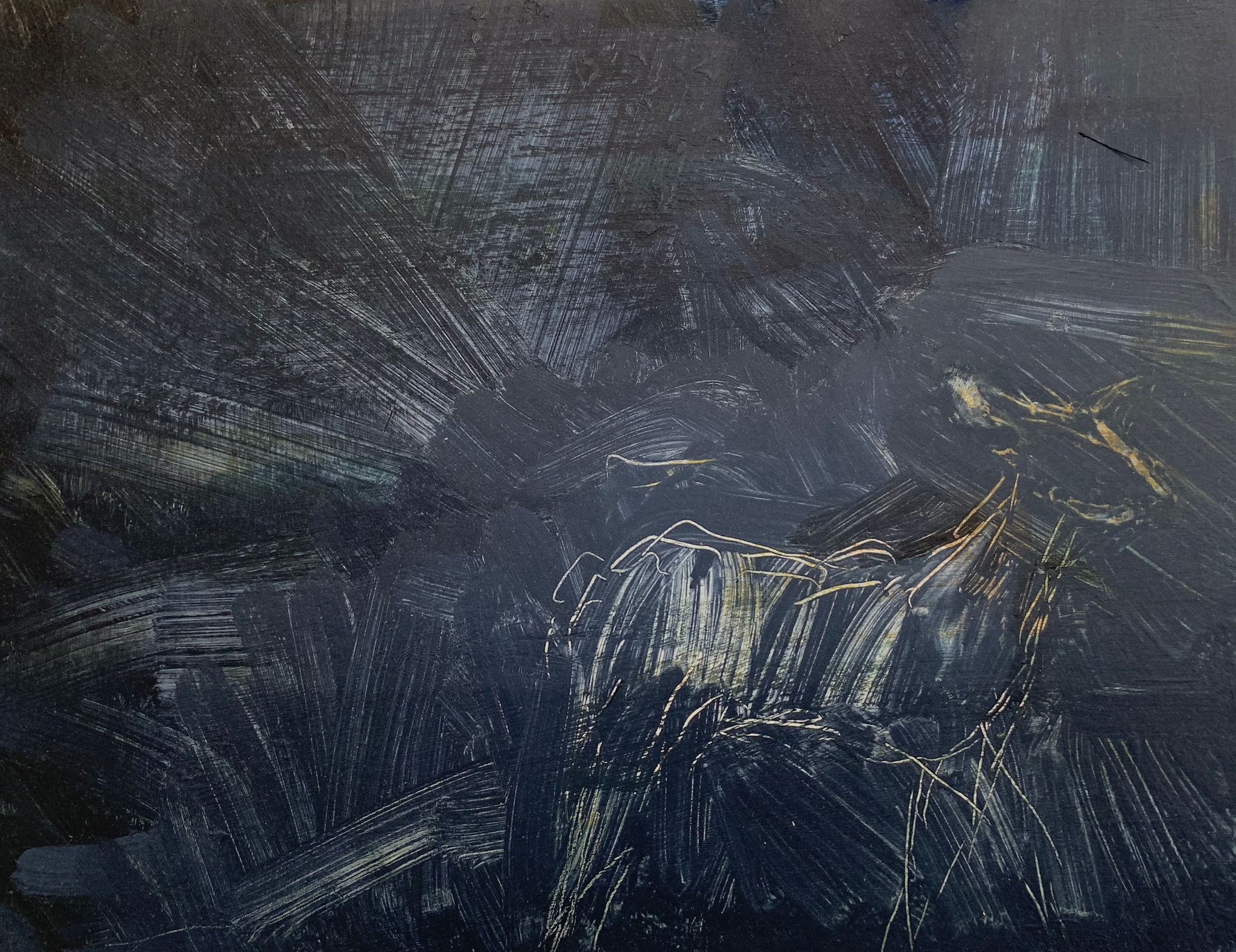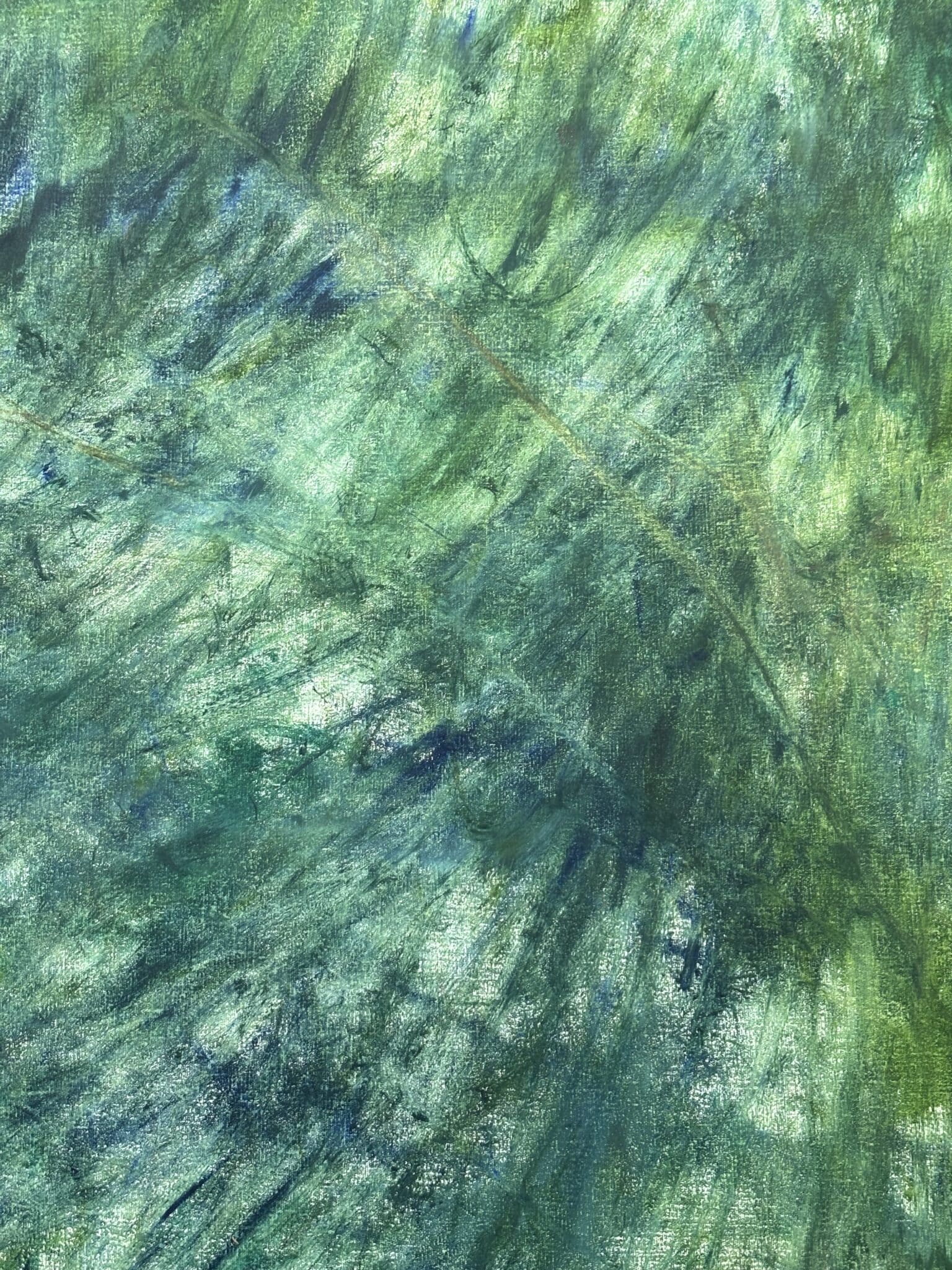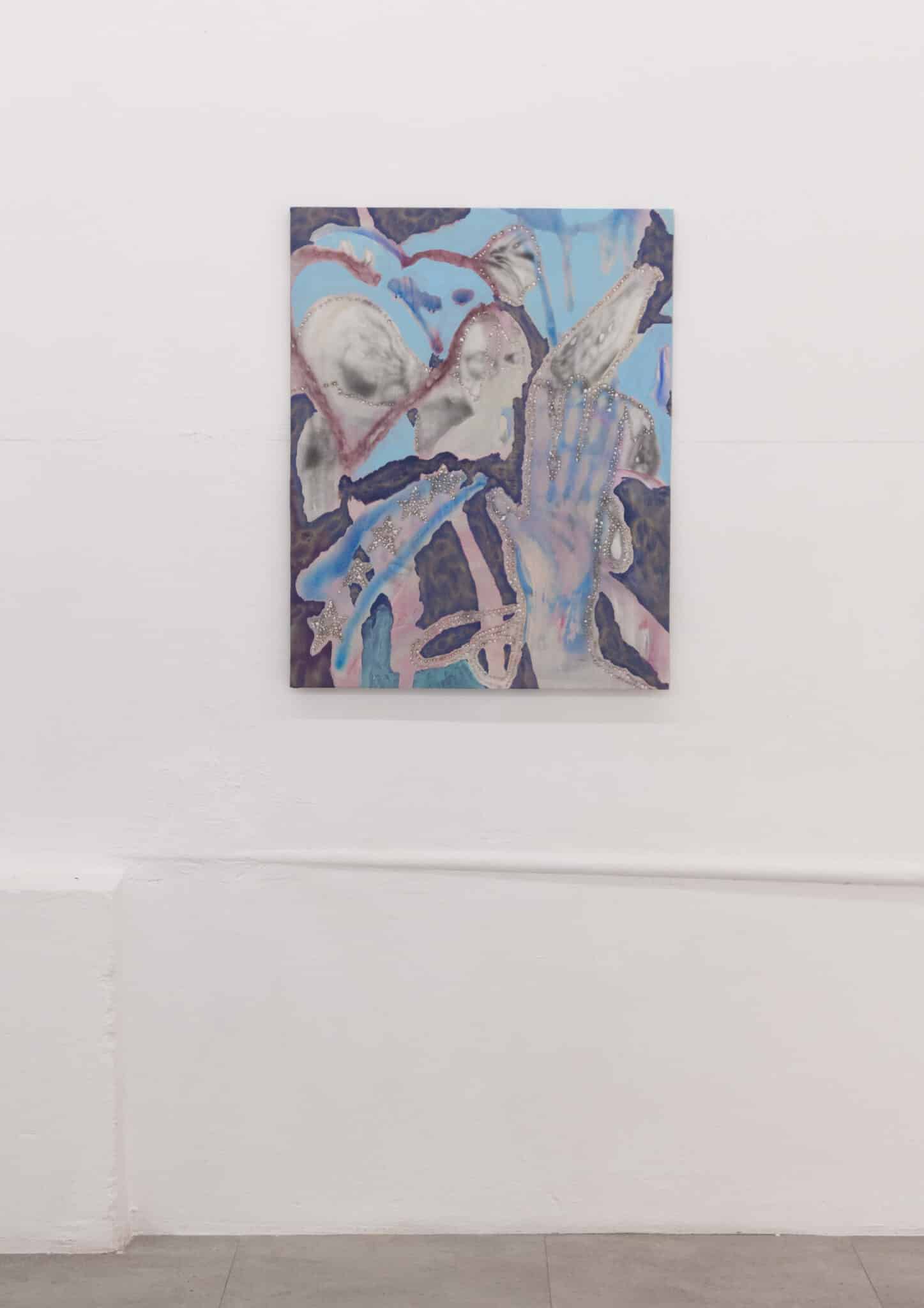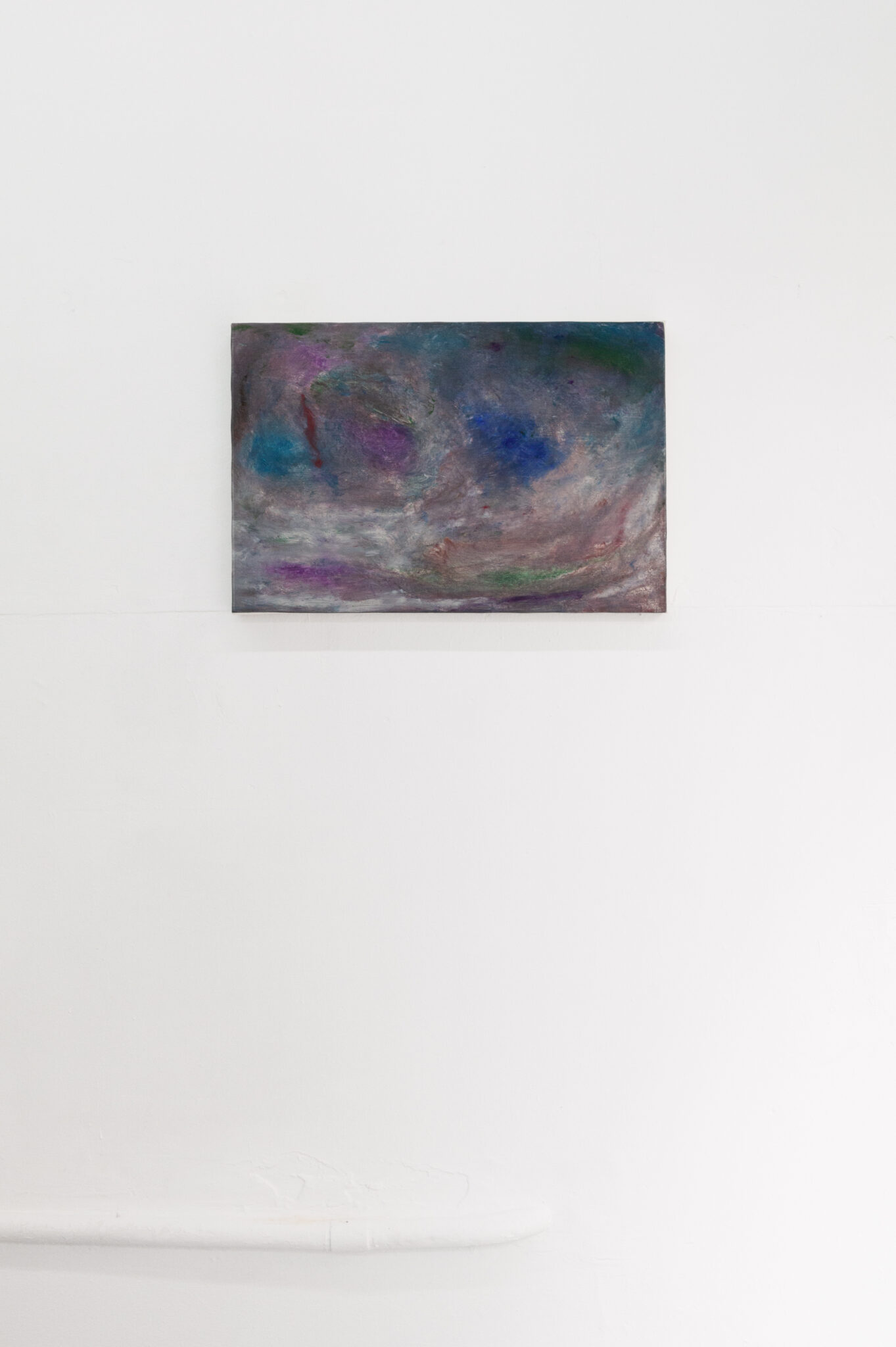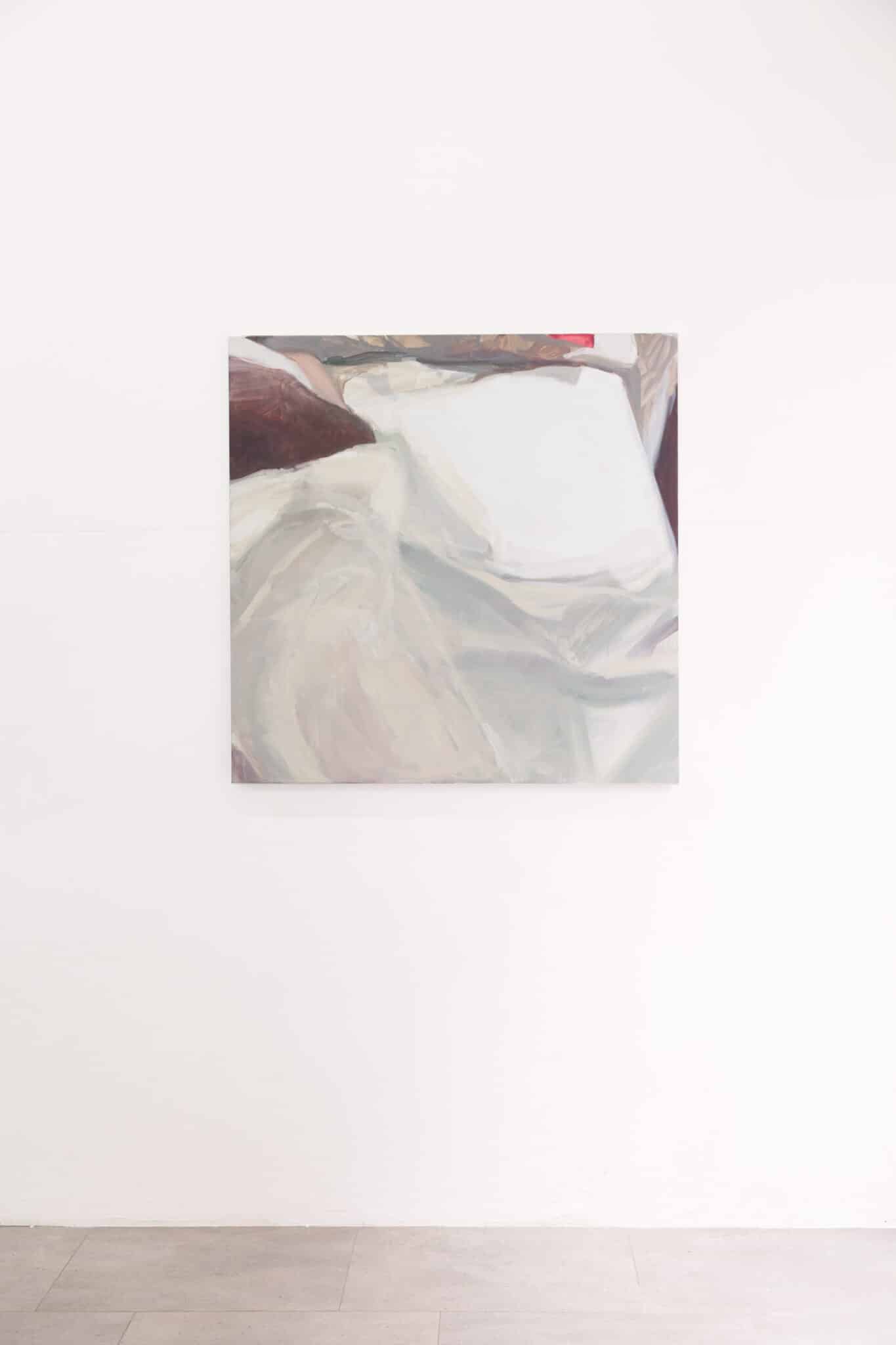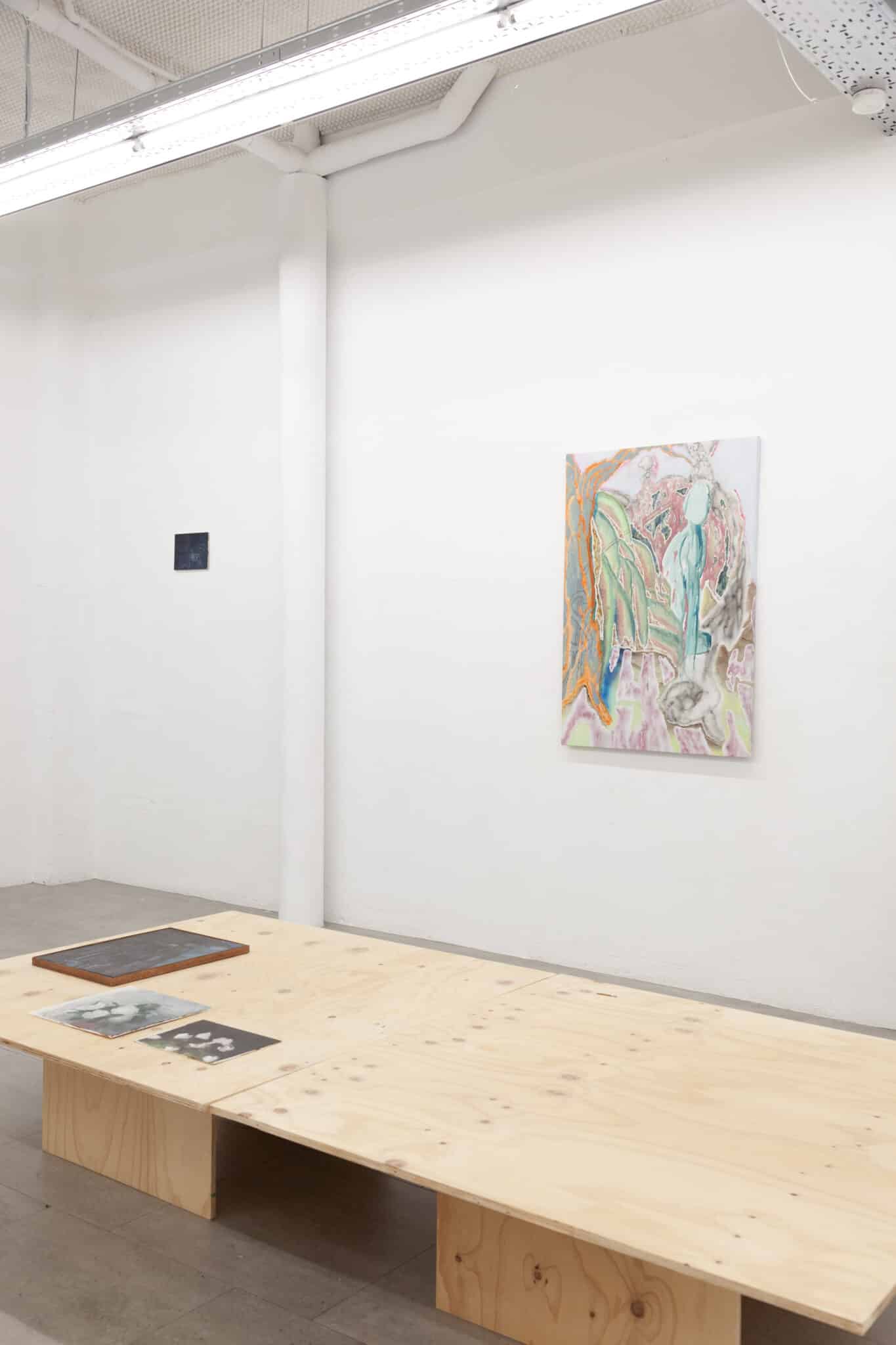13.01.24 –
29.02.24
Solos en la noche pálida
"Days when a distant word takes hold of me. I go through those days sleepwalking and transparent. The beautiful automaton sings to herself, enchants herself, tells herself cases and things: a nest of rigid threads where I dance and weep at my numerous funerals. (She is her mirror set on fire, her waiting in cold bonfires, her mystical element, her fornication of names growing alone in the pale night)" El árbol de Diana, Alejandra Pizarnik.
In this exhibition, darkness and gloom emerge as powerful scenarios for exploring the political and poetic potential of uncertainty. "Solos en la noche pálida" proposes a pictorial landscape of introspection and agitation, but also of dreamlike fantasy, desire and psychedelia. The confused, the blurred, the uncertain is proposed as a space of possibility.
The exhibition brings together a series of paintings and works on paper produced in recent years and includes pieces by Carlos García-Alix, Blanca Guerrero, Lucía Gutiérrez Vázquez, Leopoldo Mata and Alejandro Villa-Durán. Using different languages, from figurative to abstraction, the artists explore different experiences and approaches to the nocturnal, proposing night as something that goes beyond a time zone and is a friend of other notions, such as the ambiguous, the alternate, the confused. The dream, the psychedelic, the brilliant, the blindness, the excess, the refuge. A parallel dimension where silence apparently reigns and where perhaps we are more alive. In the dream the limits disappear, the unconscious emerges, in the darkness another world blossoms.
In this exhibition, darkness and gloom emerge as powerful scenarios for exploring the political and poetic potential of uncertainty. "Solos en la noche pálida" proposes a pictorial landscape of introspection and agitation, but also of dreamlike fantasy, desire and psychedelia. The confused, the blurred, the uncertain is proposed as a space of possibility.
The exhibition brings together a series of paintings and works on paper produced in recent years and includes pieces by Carlos García-Alix, Blanca Guerrero, Lucía Gutiérrez Vázquez, Leopoldo Mata and Alejandro Villa-Durán. Using different languages, from figurative to abstraction, the artists explore different experiences and approaches to the nocturnal, proposing night as something that goes beyond a time zone and is a friend of other notions, such as the ambiguous, the alternate, the confused. The dream, the psychedelic, the brilliant, the blindness, the excess, the refuge. A parallel dimension where silence apparently reigns and where perhaps we are more alive. In the dream the limits disappear, the unconscious emerges, in the darkness another world blossoms.
Carlos García-Alix
In his particular artistic approach, he immerses reality in the gloom of the night, creating paintings that materialise in just 15 minutes. His works are annotations of the night, capturing the essence of entering or leaving this mysterious period. García-Alix succeeds in capturing specific moments and states, especially at dusk, turning the night into a tangible material. His approach is formal and traditional, rooted in obvious observation, emphasising the need to be quick in his expression, reflecting the transience of the night and visually capturing the sensation of a blue sky in darkness.
Lucía Gutiérrez Vázquez
Lucía Gutiérrez Vázquez (Madrid, 1992) es una arquitecta y artista multidisciplinar cuyo enfoque pone en diálogo la pintura, el paisaje y la interacción entre el espacio físico y las experiencias sensoriales. Su formación académica incluye un Doctorado en Arquitectura en la Universidad Politécnica de Madrid (2019 - actualidad) y una amplia formación complementaria en el ámbito de la comunicación arquitectónica, la pintura y la historia del arte.
A lo largo de su carrera ha participado en exposiciones individuales y colectivas destacadas, entre ellas la Bienal de Arquitectura de Venecia (2018) y el Festival de Fotografía de Coruña (2018), mostrando una amplia versatilidad en disciplinas artísticas como la fotografía, la pintura y la escenografía. Su obra explora temáticas que vinculan el espacio arquitectónico con la percepción humana.
Lucía ha sido reconocida con numerosos premios y becas, como el Primer Premio Certamen Jóvenes Creadores (2021), además de recibir varias becas para la formación de profesorado universitario por el Ministerio de Universidades (2020-2024). Su obra ha sido publicada en revistas académicas y libros sobre arquitectura y arte contemporáneo.
Su práctica aborda lo cotidiano a través de una exploración íntima del color y el espacio con la serenidad de quien no pretende asumir la lógica visual, en ocasiones excesiva y ruidosa, de los tiempos modernos. Lucía Gutiérrez acoge en sus lienzos, de pincelada espesa y abocetada, la inmensidad de lo que se desliza por su mirada: una mirada que dignifica con la misma destreza la luz incidiendo sobre un paisaje como la frágil materialidad de un barquito de papel. La pintura funciona aquí como un eslabón sigiloso que sostiene el salto que hay entre la imagen real que las cosas ofrecen y la mirada que las recorre.
A lo largo de su carrera ha participado en exposiciones individuales y colectivas destacadas, entre ellas la Bienal de Arquitectura de Venecia (2018) y el Festival de Fotografía de Coruña (2018), mostrando una amplia versatilidad en disciplinas artísticas como la fotografía, la pintura y la escenografía. Su obra explora temáticas que vinculan el espacio arquitectónico con la percepción humana.
Lucía ha sido reconocida con numerosos premios y becas, como el Primer Premio Certamen Jóvenes Creadores (2021), además de recibir varias becas para la formación de profesorado universitario por el Ministerio de Universidades (2020-2024). Su obra ha sido publicada en revistas académicas y libros sobre arquitectura y arte contemporáneo.
Su práctica aborda lo cotidiano a través de una exploración íntima del color y el espacio con la serenidad de quien no pretende asumir la lógica visual, en ocasiones excesiva y ruidosa, de los tiempos modernos. Lucía Gutiérrez acoge en sus lienzos, de pincelada espesa y abocetada, la inmensidad de lo que se desliza por su mirada: una mirada que dignifica con la misma destreza la luz incidiendo sobre un paisaje como la frágil materialidad de un barquito de papel. La pintura funciona aquí como un eslabón sigiloso que sostiene el salto que hay entre la imagen real que las cosas ofrecen y la mirada que las recorre.
Blanca Guerrero
(Madrid/New York, 1991) merges photography, painting and collage to create suggestive spaces, where light in shadow takes on a singular protagonism. Her creative process begins with a conscious observation, renouncing herself in front of landscapes or significant moments. In her work, she seeks to perpetuate the sensorial essence of ephemeral phenomena such as the glare of the sun, the darkness of the night and the nuances of the half-light. Guerrero aspires to give physical dimension to fleeting perceptions, revealing the light in all darkness. The selective elimination of light in her work gives form to the composition, emerging figures, horizons and lights behind mountains through a manual and mystical process. Her approach aims to capture a perpetual state of gloom, becoming a witness and constantly pursuing the ephemeral essence of observation, a constant escape that evokes the Japanese concept of "yugen".
Leopoldo Mata
(Badajoz, 1994) After finishing his degree in Fine Arts in Cuenca, he spent several years in Paris developing himself as a tattoo artist. On his return to Spain he studied the master Landa (Annual Laboratory to Nurture Artistic Dispersion) in Espositivo, at which point he resumed his artistic practice as a painter until now.
"If there is a pattern that I feel comfortable with in my approach to my work, it is the juxtaposition of different visual languages as a consequence of abandoning ideas halfway through execution that are often overlapped with other ideas/systems, evoking dispersion and the non-apprehension of any truth. I am interested in creating from the noise and the continuous interruption that characterises our present by including it in the pictorial process; playing with concepts seriously for a while to demolish them later with a sensation generating a miscellany that speaks of my way of understanding the contemporary world".
"If there is a pattern that I feel comfortable with in my approach to my work, it is the juxtaposition of different visual languages as a consequence of abandoning ideas halfway through execution that are often overlapped with other ideas/systems, evoking dispersion and the non-apprehension of any truth. I am interested in creating from the noise and the continuous interruption that characterises our present by including it in the pictorial process; playing with concepts seriously for a while to demolish them later with a sensation generating a miscellany that speaks of my way of understanding the contemporary world".
Alejandro Villa-Durán
(Jalisco, 1993) is a graduate of the Royal College of Art, London. He previously studied Textile Design at Central Saint Martins London.
The starting point of his pictorial and sculptural work is “intuitive choreography”, a term that condenses a methodological repetition: going out, moving about in order to return, and then tracing the route. In general, these trips outside the city seek for the body to become the means for an attentive presence in its surroundings. The wager is not on an interpretation of the natural, but rather on a singular relation that allows the general body a differential when affected by the encounter: that is, by the unpredictable. The sensation opens up and the perception responds not by precipitating the signs, but by establishing a line of interpretation, a position–with a view to being shared–about what is experienced.
Upon returning, the second part of the process begins. Thinking of production as a kind of transit, Alejandro usually works in series that allow me to explore what has been lived and experienced, while this is affected by each medium’s materials and conditions.
In painting, the limit is the color palette itself, which I select before starting. More than a representation, painting is for me a choreography that begins and ends with the body: the hand traces, but the body moves on the canvas. This emits a temporality linked to the trance between painting and memory; painting is the presence in front of the picture, while memory (of the journey that precedes the practice) is the counterpoint that builds the rhythm of the composition. In it, the overlapping of marks and blotches is as relevant as the void that sustains both the experience and the image.
The starting point of his pictorial and sculptural work is “intuitive choreography”, a term that condenses a methodological repetition: going out, moving about in order to return, and then tracing the route. In general, these trips outside the city seek for the body to become the means for an attentive presence in its surroundings. The wager is not on an interpretation of the natural, but rather on a singular relation that allows the general body a differential when affected by the encounter: that is, by the unpredictable. The sensation opens up and the perception responds not by precipitating the signs, but by establishing a line of interpretation, a position–with a view to being shared–about what is experienced.
Upon returning, the second part of the process begins. Thinking of production as a kind of transit, Alejandro usually works in series that allow me to explore what has been lived and experienced, while this is affected by each medium’s materials and conditions.
In painting, the limit is the color palette itself, which I select before starting. More than a representation, painting is for me a choreography that begins and ends with the body: the hand traces, but the body moves on the canvas. This emits a temporality linked to the trance between painting and memory; painting is the presence in front of the picture, while memory (of the journey that precedes the practice) is the counterpoint that builds the rhythm of the composition. In it, the overlapping of marks and blotches is as relevant as the void that sustains both the experience and the image.






